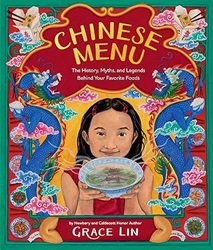
 Chinese Menu
Chinese MenuThe History, Myths, and Legends Behind Your Favorite Foods
Review posted January 9, 2024.
Little, Brown and Company, 2023. 288 pages.
Review written January 3, 2024, from a library book.
Starred Review
2023 Sonderbooks Stand-out:
#2 Children's Nonfiction
This book is amazing. I read it slowly, story by story, and then made sure to finish up on New Year's Eve so that I could make it one of my top Sonderbooks Stand-outs for 2023.
Grace Lin has won all the Honors: Newbery Honor, Caldecott Honor, Geisel Honor, National Book Award for Young People's Literature Finalist, Mathical Book Prize Honor, and Children's Literature Legacy Award Winner. Now I find myself hoping she'll add Sibert Honor (or Medal) to that list, the award for Children's Nonfiction.
This book itself is exquisite, decorated throughout with Grace Lin's beautiful art. It's a large, almost square format, and would work nicely as a coffee table book when you're not poring through it.
What Grace Lin has done here is tell you stories behind food that appears on the menu of American Chinese restaurants. Here's how she introduces it:
Have you ever eaten at a Chinese restaurant? Yes, I know, the food was so good! Yum! I get hungry just thinking about it.
But have you ever been curious about the names of the dishes you ordered there? For example, General Tso's Chicken -- have you wondered who General Tso was? Or Buddha Jumps Over the Wall -- why would Buddha do something like that?
Well, I can tell you! Because those names are all clues to the tales behind the food. Almost all dishes on a Chinese menu have a story behind them. In a way, the menu at your Chinese restaurant is the table of contents for a feast of stories.
And this book is that feast.
That tells you what this book is -- mostly a book of tales about how various dishes (so many of them!) were developed, most of them hundreds of years ago, with a timeline at the front of the book of Chinese dynasties and how the various dishes fit into them.
The tales are wonderful -- Grace Lin is a delightful (Newbery-Honor-winning!) storyteller. But there's even more than that in this book. Before she tells each story, she talks a bit about the dish itself and often her experience with it and what you might experience with it. The art all throughout the book (from a Caldecott Honor Winner!) is also amazing and detailed and beautiful.
I was entertained by these stories, but along the way I also learned all kinds of things about Chinese and American history and about food. Her research was amazing - there are 33 pages of back matter, including a detailed Bibliography. Yes, there's lots of invented dialogue and modifications in the stories. This isn't an academic work, and she's a storyteller. But she's transparent about the modifications she made and the reasoning behind them. Here's how she explains that in the Introduction (with further explanations with individual stories):
Yes. These stories are real. They are real legends, real myths, and real histories. I did not make any of them up from my own imagination. They have all been researched (you can check the bibliography!) and there are a few stories that are not only real folklore but factually true, too!
That said, even though I did not fabricate any of these stories, I did, however, embellish some of them. Many of these stories are my own adapted retellings, combining various versions of legends together with imagined details and dialogue. But even when I did so, I tried hard to stay true to the spirit of the original tales and keep as many details as possible. For example, important female characters in the legends were sometimes nameless, so I gave these women names, with ones that would be appropriate for that time and place. But when the stories did name characters, I kept true to the tale -- if the characters had no last name in the legend (such as Kun in the chopstick story), I left them with a single name. And, speaking of names, in Chinese tradition, the last name is said first and written before the given name. So, General Ding Baozhen -- a real historical person -- has the last name of Ding. The general's first name is Baozhen. You can read Baozhen's story while learning about Kung Pao Chicken!
I definitely need to visit a Chinese restaurant after reading this book!
